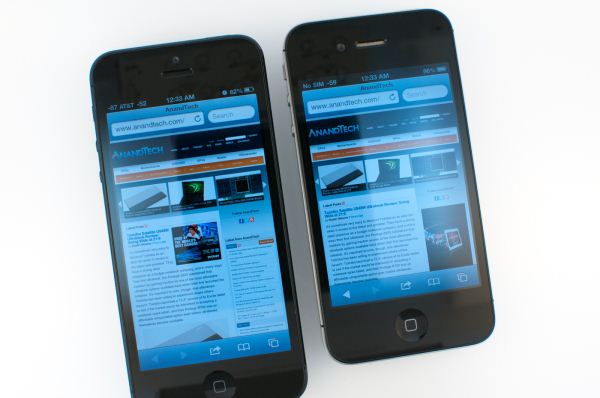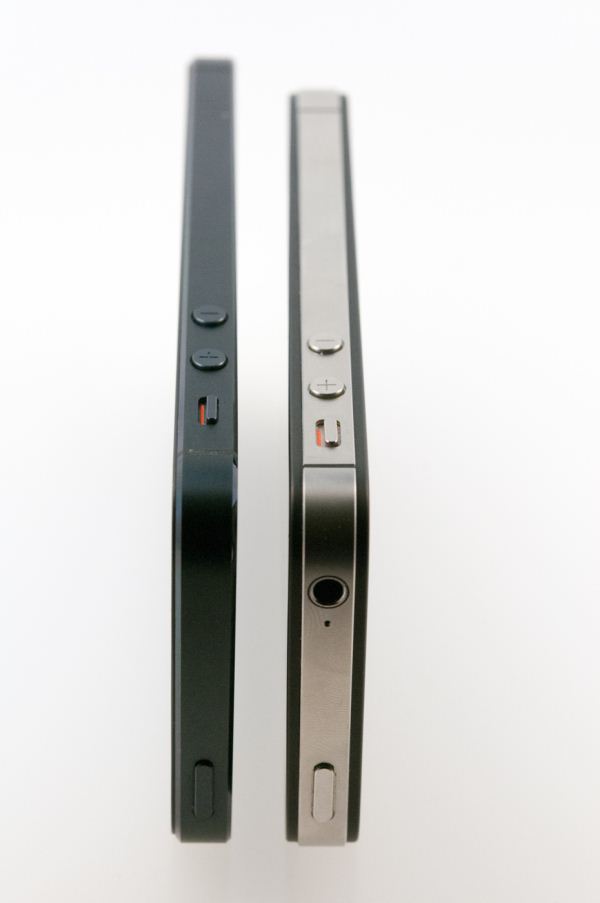The iPhone 5 Review
by Anand Lal Shimpi, Brian Klug & Vivek Gowri on October 16, 2012 11:33 AM EST- Posted in
- Smartphones
- Apple
- Mobile
- iPhone 5
The last significant redesign of the iPhone platform came in 2010 with the iPhone 4. It was an update that literally touched all aspects of the device, from SoC to display to baseband and of course, chassis. Last month’s launch of the iPhone 5 is no different in magnitude. The sixth generation iPhone makes some of the biggest changes to the platform since its introduction in 2007.
Visually the device begins by evolving the design language of the iPhone 4/4S chassis. From the launch of the iPhone 4 it was quite obvious that Apple had picked a design it was quite proud of. Thus it’s not too surprising that, from a distance, the iPhone 5 resembles the previous two iPhone models. We’ll get into material differences shortly, but what make the iPhone 5 design such a radical departure is its larger display.
All previous iPhones have maintained the same 3.5-inch, 3:2 aspect ratio display. With the rest of the world quickly moving to much larger displays, and with 16:9 the clear aspect ratio of choice, when faced with the decision of modernizing the iPhone platform the choice was obvious.
The iPhone 5 embraces a taller, 4-inch, 16:9 1136 x 640 display opting to lengthen the device instead of increasing its area in both dimensions. The result is a device that is distinctly an iPhone, albeit a modern one. The taller display doesn’t do much to make desktop web pages any easier to read as a result of the width staying the same. Those longing for an HTC One X or Galaxy S 3 sized device running iOS are out of luck. Reading emails and typing are both improved though as there’s now more room for lists and the keyboard no longer occupies as much of the display. The taller device can be more awkward to use if you have smaller hands, but the added screen real estate is honestly worth it. Once you get used to the iPhone 5’s display, going back to the older models is tough.
The taller chassis went on a diet as well. The iPhone 5 is now considerably thinner and lighter than its predecessor, which is yet another factor that contributes to it feeling more modern.
Internally the device changes are just as significant, if not more, than those on the outside. The iPhone 5 includes LTE support, which in areas where LTE networks are deployed can be enough reason alone to warrant an upgrade.
The iPhone 5 also includes a brand new SoC from Apple: the A6. For the first time since the introduction of the iPad, Apple has introduced a major branded SoC on an iPhone first. The iPhone 4 used the A4 after it debuted on the iPad, and the 4S picked up the A5 months after the iPad 2 launched with it. The A6 however arrives first on the iPhone 5, and with it comes two of Apple’s first, custom designed CPU cores. We’ve always known Apple as a vertically integrated device and software vendor, but getting into CPU design takes that to a new level.
| Physical Comparison | ||||
| Apple iPhone 4S | Samsung Galaxy S 3 (USA) | HTC One S | Apple iPhone 5 | |
| Height | 115.2 mm (4.5") | 136.6 mm (5.38" ) | 130.9 mm (5.15" ) | 123.8 mm (4.87") |
| Width | 58.6 mm (2.31") | 70.6 mm (2.78") | 65 mm (2.56") | 58.6 mm (2.31") |
| Depth | 9.3 mm ( 0.37") | 8.6 mm (0.34") | 7.8 mm (0.31") | 7.6 mm (0.30") |
| Weight | 140 g (4.9 oz) | 133g (4.7 oz) | 119.5g (4.21 oz) | 112 g (3.95 oz) |
| CPU | Apple A5 @ ~800MHz Dual Core Cortex A9 | 1.5 GHz MSM8960 Dual Core Krait | 1.5 GHz MSM8260A Dual Core Krait | 1.3 GHz Apple A6 (Dual Core Apple Swift) |
| GPU | PowerVR SGX 543MP2 | Adreno 225 | Adreno 225 | PowerVR SGX 543MP3 |
| RAM | 512MB LPDDR2-800 | 2 GB LPDDR2 | 1 GB LPDDR2 | 1 GB LPDDR2 |
| NAND | 16GB, 32GB or 64GB integrated | 16/32 GB NAND with up to 64 GB microSDXC | 16 GB NAND | 16, 32, or 64 GB integrated |
| Camera | 8 MP with LED Flash + Front Facing Camera | 8 MP with LED Flash + 1.9 MP front facing | 8 MP with LED Flash + VGA front facing | 8 MP with LED Flash + 1.2MP front facing |
| Screen | 3.5" 960 x 640 LED backlit LCD | 4.8" 1280x720 HD SAMOLED | 4.3" 960x540 Super AMOLED | 4" 1136 x 640 LED backlit LCD |
| Battery | Internal 5.3 Whr | Removable 7.98 Whr | Removable 6.1 Whr | Internal 5.45 Whr |
There’s a lot to talk about when it comes to the new iPhone. Whether it is understanding the architecture of the A6 SoC or investigating the improved low light performance of the iPhone 5’s rear facing camera, we’ve got it here in what is easily our most in-depth iPhone review to date. Let’s get started.












276 Comments
View All Comments
medi01 - Wednesday, October 17, 2012 - link
1) Compare ipad2's gamut, cough2) Check values on toms
http://media.bestofmicro.com/3/4/331888/original/g...
http://www.tomshardware.com/reviews/ipad-3-benchma...
Unlike anand, toms was beyond primitive contrast/brightness benchmarking for quite a while.
thunng8 - Thursday, October 18, 2012 - link
Not sure if I should trust Tom's figures compared to Anands's.In any case, both show the ipad3 has higher gamut, especially in sRGB.
steven75 - Wednesday, October 17, 2012 - link
I think what you meant to say is that AMOLEDs win on black levels and that's about it. LCDs still win in accuracy and most importantly ability to see them in outdoor settings.KoolAidMan1 - Tuesday, October 16, 2012 - link
Not even close. Even the better Android displays like the Galaxy S3 has a PenTile display. Despite having more "pixels" it actually has fewer subpixels than the iPhone does. Unless you have bad eyesight the S3 display looks really bad in comparison, and this is before we get to even worse smartphone displays out there by HTC, etc.Sufo - Tuesday, October 16, 2012 - link
Old pentile displays were visibly jaggy on vertical lines - even my old lumia 800 exhibited this to some extent. On the GS3 tho, it is not noticeable and it has nothing to do with eyesight.Your comment makes it sound (to someone who has seen many different smartphone displays in person) as though you haven't spent much time with the GS3 (read: many smartphones) at all. Simply mentioning that is uses pentile subpix config, from you, sounds like regurgitated information. Not only that, but you seem to gloss over the many benefits that amoled panels bring. It's arguable that these benefits are more important than an accurate colourspace on (specifically) a mobile phone - although it is ofc entirely subjective.
This brings me to the last tell of ignorance I noted; your mention of HTC. Have you used a One X? For those who do not like amoled panels, the display on the one x is perhaps nicer than both the gs3 and the ip5. Ofc you may say Android is not your cup of tea, and that's a perfectly justifiable stance, however it has nothing to do with display tech.
tl;dr You sound like you don't know what you're talking about
KoolAidMan1 - Tuesday, October 16, 2012 - link
I do know what I'm talking about given that I've seen many smartphones, and I've calibrated my share of desktop displays to sRGB.Differences in display tech aside, Android phones have never gotten color profiles right, EVER. They're almost always oversaturated, have too much contrast, and are inaccurate. Anand even posted a difference in color accuracy between several devices, and the profile for the S3 is totally what I expected.
The S3 really doesn't look good, period, but then again there are people who argue that TN panels are just fine against IPS. I'm used to hearing nonsense on forums when it comes to display from people who don't know what to look for.
KoolAidMan1 - Tuesday, October 16, 2012 - link
BTW, apologies if that came out harsh, but the difference in color and contrast accuracy between something like the S3 and a properly calibrated device is a night and day difference to me. I'm pretty sensitive to display quality though; my main desktop display at home is still an NEC and my plasma is a Pioneer Elite (RIP)rocketbuddha - Tuesday, October 16, 2012 - link
For Android you have the following 720p HD DisplaysSLCD - HTC Rezound (2011 tech)
SLCD 2 - HTC One X, Sony HD
HD SAMOLED Pentile - GS3, Galaxy Nexus, Moto Razr HD
HD SAMOLED RGB - Galaxy Note II
True IPS LCD - LG Optimus 4X, Optimus G
Super IPS LCD -Asus Padphone, Sharp phones etc
So you have big set of choices. If dark contrasts are important then SAMOLED is the way to go. SAMOLED RGB over SAMOLED Pentile.
If overall color and whites are important go with SLCD2.
IPS LCDs are the closest to the Retina Display and u have a choices there too. You can pick and choose what is good for you and have alternatives.
Spunjji - Thursday, October 18, 2012 - link
The HTC One X has what is hailed to be one of the best LCD smartphone displays out there. Your claim is invalid.Similarly, the Galaxy Note 2 has an AMOLED display without PenTile. Sure, it's lower density, but one does not hold a 5.5" screen so close to one's face.
medi01 - Wednesday, October 17, 2012 - link
""The iPhone 5 display is better than any current Android display.""Why don't you go hit your dumb head with something heavy, ipad would do?